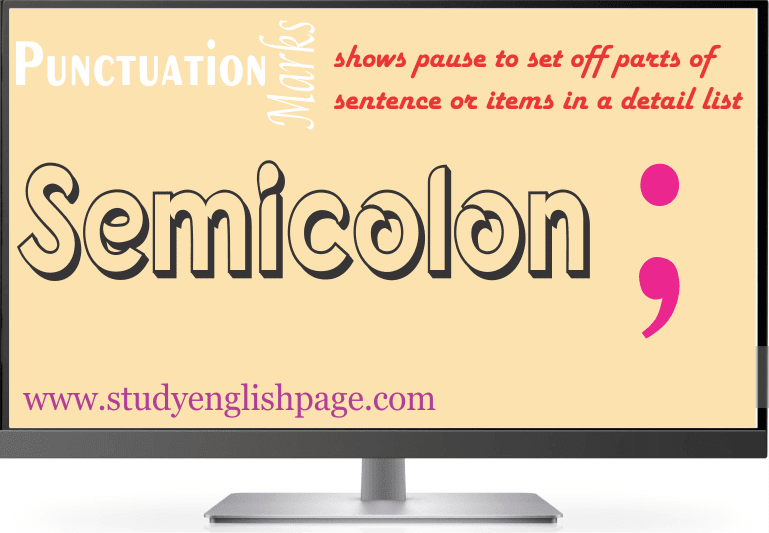Semicolon
What is Semicolon?
A semicolon is one of the punctuation marks that shows a pause
to set off parts of a sentence or items in a detailed list. The pause it shows is
longer than a comma but shorter than a full stop.
- The old house is cheap; the new house is expensive.
- The old car is cheap, but the new car is expensive.
- Weather forecasting agencies have forecasted bad weather conditions; consequently, all flights have been delayed.
Definitions from other Dictionaries
Oxford Advanced Learners’ Dictionary defines the semicolon as the
mark ( ; ) used
to separate the parts of a complicated sentence or items in a detailed list,
showing a break that is longer than a comma but shorter than a full stop.
Cambridge Dictionary defines the semicolon as the symbol (;) used in writing between two parts of a sentence, usually when
each of the two parts could form grammatical sentences on their own.
A semicolon can also separate the things in a list.
Uses of Semicolons
Links Two Related Independent Clauses
We use a semicolon to join two independent clauses that are
closely related to one another. In other words, if we have two sentences and
want to conjoin in one sentence due to their close relations, we use a semicolon.
- The monsoon has arrived; it will rain every day.
- They have offered up to 50% discount; we have offered up to 80% discount.
Substitute for Conjunction
We use a semicolon to join two closely linked sentences or two
independent clauses when we don’t want to use any coordinating conjunctions. In
other words, we can say that semicolon is a substitute for a coordinating conjunction.
It replaces the conjunctions, such as and, but, etc.
- The old car is cheap, but the new car is expensive.
- The old car is cheap; the new car is expensive.
- I saw Mr. Ali and he was talking to someone.
- I saw Mr. Ali; he was talking to someone.
Between Items of Series (containing internal commas)
Sometimes items of series have their internal commas. In
this case, we use a semicolon between the items to separate items of a series. If we
just use commas, the reader will not be able to get the meaning. He will be in
confusion. To avoid confusion, a semicolon is an option.
- Our board of directors consists of Ali, from Pakistan; Nabeel, from India; Fahad, from Dubai; Tom, from America; and John, from Germany.
- The most famous teachers in our university are Shabir, Chemistry; Adeel, Physics; Aziz, Management; John, Economics; and Saleem, Mathematics.
With Conjunctive Adverbs
A semicolon is used between two independent clauses when they
are connected by conjunctive adverbs. Consequently, therefore, however, and
finally, etc. are examples of conjunctive adverbs.
- All the students were instructed to come on time; however, Tom and Adil came late.
- The majority of the students were late; therefore, we gave the test a little bit late.
Between Independent Clauses
We can use a semicolon between independent clauses joined by
coordinating conjunctions when a comma or commas are used in the first clause.
Coordinating conjunctions include and, but, etc.
- My friends write with a word processor, tablet, or phone; but I write with a pen or pencil.
- The car which my friend has bought is old, cheap, and well designed; and I want to buy it.
In Elliptical Construction
Sometimes we omit a word or some words from a sentence to
make it concise. In this case, we use a semicolon to maintain the clearance
of sentences.
- In 1990, 90% people cast their votes; in 1996, 80%; in 2017, just 60%.
- We had a lunch party in our class yesterday. Some class fellows brought chicken roast; some chicken roast; some custard; others soft drinks.

